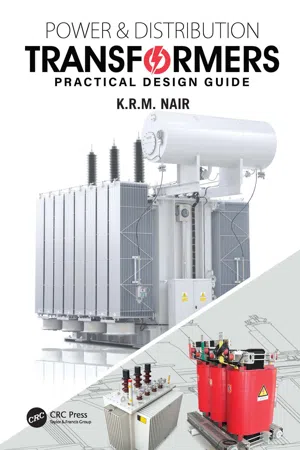
- 473 pages
- English
- ePUB (mobile friendly)
- Available on iOS & Android
About this book
This book is based on the author's 50+ years experience in the power and distribution transformer industry. The first few chapters of the book provide a step-by-step procedures of transformer design. Engineers without prior knowledge or exposure to design can follow the procedures and calculation methods to acquire reasonable proficiency necessary to designing a transformer.
Although the transformer is a mature product, engineers working in the industry need to understand its fundamentals oand design to enable them to offer products to meet the challenging demands of the power system and the customer. This book can function as a useful guide for practicing engineers to undertake new designs, cost optimization, design automation etc., without the need for external help or consultancy.
The book extensively covers the design processes with necessary data and calculations from a wide variety of transformers, including dry-type cast resin transformers, amorphous core transformers, earthing transformers, rectifier transformers, auto transformers, transformers for explosive atmospheres, and solid-state transformers. The other subjects covered include, carbon footprint salculation of transformers, condition monitoring of transformers and design optimization techniques.
In addition to being useful for the transformer industry, this book can serve as a reference for power utility engineers, consultants, research scholars, and teaching faculty at universities.
Frequently asked questions
- Essential is ideal for learners and professionals who enjoy exploring a wide range of subjects. Access the Essential Library with 800,000+ trusted titles and best-sellers across business, personal growth, and the humanities. Includes unlimited reading time and Standard Read Aloud voice.
- Complete: Perfect for advanced learners and researchers needing full, unrestricted access. Unlock 1.4M+ books across hundreds of subjects, including academic and specialized titles. The Complete Plan also includes advanced features like Premium Read Aloud and Research Assistant.
Please note we cannot support devices running on iOS 13 and Android 7 or earlier. Learn more about using the app.
Information
1 Transformer Design
1.1 Introduction
1.2 Definition of Transformer
A static piece of apparatus with two or more windings which by electromagnetic induction transform a system of alternating voltage and current into another system of voltage and current, usually of different values and at the same frequency for the purpose of transmitting electric power.
A static electric device consisting of two or more windings with or without a magnetic core for producing mutual coupling between electric circuits.
1.3 Design Objectives
- Design the transformer by selecting the most suitable materials to reduce the cost of the product
- Optimize the lifetime owning cost of the product
- Design environmental-friendly and safe product
- Develop product suitable to meet the evolving requirement of the grid and customer
- Adapt new technologies and offer continuous improvements
Table of contents
- Cover
- Half Title
- Title Page
- Copyright Page
- Table of Contents
- Preface
- Acknowledgments
- Author
- Chapter 1 Transformer Design
- Chapter 2 Brief History of Transformers and the Emerging Trends
- Chapter 3 Design Procedures
- Chapter 4 Core Design: Core Area Calculation
- Chapter 5 Winding Design
- Chapter 6 Calculation of Load Loss
- Chapter 7 Calculation of Reactance
- Chapter 8 Calculation of Core Frame Size, Core Losses, Efficiency and Regulation
- Chapter 9 Lightning and Switching Surges on Transformers
- Chapter 10 Inrush Current in Transformers
- Chapter 11 Calculation of Core and Coil Assembly Dimensions, Tank Size and Tank Weight
- Chapter 12 Calculation of Winding Gradient, Heat Dissipation Area and Oil Quantity
- Chapter 13 Calculation of Pressure Rise, Stresses and Strength of Tank
- Chapter 14 Calculation of the Short Circuit Forces and Strength of Transformers
- Chapter 15 Rectifier Transformers
- Chapter 16 Cast Resin Transformers
- Chapter 17 Earthing Transformers
- Chapter 18 Amorphous Core Transformers
- Chapter 19 Design of Current-Limiting Reactors
- Chapter 20 Scott-Connected Transformers
- Chapter 21 Autotransformers
- Chapter 22 Transformers for Special Applications or Special Designs
- Chapter 23 Transformers for Renewable Energy Applications
- Chapter 24 Condition Monitoring of Oil-Filled Transformers
- Chapter 25 Carbon Footprint Calculation of Transformer
- Chapter 26 Seismic Response Calculation for Transformers
- Chapter 27 Solid-State Transformer
- Chapter 28 Transformer Design Optimization
- Chapter 29 Corrosion Protection
- Chapter 30 Calculation of Miscellaneous Technical Parameters
- A.1 Design of 1000 kVA, 11/0.4 kV, ONAN Transformer
- A.2 Design of 20 MVA, 33/11.5 kV, ONAN Transformer
- A.3 Design of 72/90 MVA, 132/34.5 kV, ONAN/ONAF Transformer
- A.4 Finite Element Methods for Transformer Design
- A.5 Total Owning Cost (TOC) of a Transformer
- A.6 Comparison of IEC 60076 and ANSI/IEEE C.57.12 Standards
- Bibliography
- Index